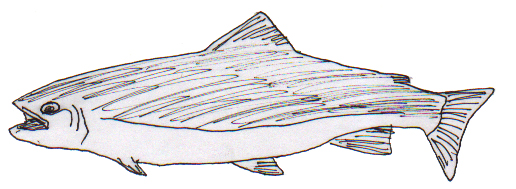 Marshall
Cultural Atlas Marshall
Cultural Atlas
This collection of student work is from
Frank Keim's classes. He has wanted to share these works for others
to use as an example of Culturally-based curriculum and documentation. These
documents have been OCR-scanned. These are available
for educational use only.
King or Chinook Salmon
(Oncorhynchus tshawytscha)
(Taryaqvak)
The King Salmon is Alaska's State fish and one of
its most important sport and commercial fish. It is the largest of
all Pacific salmon weighing from 30-126 pounds. In the lower 48, they
call the King salmon Chinook. In British Columbia they call it Spring
salmon. Other names are: quinnat, tyee, tule and black
mouth.
They range from the Monterey Bay area in
California to the Chukchi Sea in Alaska. They also occur on the Asian
coast from the Anadyr River of Siberia southeast to Hokkaido, Japan.
In Alaska they occur from the southeastern panhandle to the Yukon
River.
The adults are distinguished by their large size
and by the black irregular spotting on their back and dorsal fins and
on both lobes of the caudal or tail fin. King salmon are called "black mouth" by the black pigment along the gum line. In the ocean
they have a bluish green coloration on their back which fades to a
silver color on both sides. They have a white belly. Fresh water
colors of spawning King salmon range from red to copper to almost
black. Distinguished by their "ridge back" condition and by their
hooked nose or upper jaw, males are more deeply colored than
females.
King salmon are anadromous, which means they hatch
in fresh water and they spend part of their life in the ocean. All
Kings die after they spawn. They become sexually mature from the
second through seventh year, and, as a result, may vary greatly in
size when they spawn. Each female deposits 3,000-14,000 eggs in
gravel nests, or redds, which the female excavates in relatively deep
moving water. Here in Alaska the eggs hatch in late winter or early
spring. Juvenile Kings first feed on plankton in fresh water. Later
they eat insects. In Alaska juvenile Kings remain in fresh water
until the spring when they migrate as smolt to the ocean. They eat a
variety of organisms, including herring, pilchard, sand lance, squid
and crustaceans.
Alaska's commercial King harvest averaged about
639,000 fish in 1949. This was worth $6 million. The King salmon has
an excellent market, especially in Japan, because of its large size
and high oil content.
Subsistence Eskimo and Indian fishermen in the
Yukon and Kuskokwim Rivers catch an average of 60,000 Kings per year.
The salmon is also the most highly prized sport fish in Alaska. The
sport fishing harvest of King salmon is over 26,000 annually, with
Cook Inlet and adjacent watersheds contributing over half of the
catch.
Lois Moore

Christmastime Tales
Stories real and imaginary about Christmas, Slavik, and the New Year
Winter, 1996 |
Christmastime Tales II
Stories about Christmas, Slavik, and the New Year
Winter, 1998 |
Christmastime Tales III
Stories about Christmas, Slavik, and the New Year
Winter, 2000 |
| Summer Time Tails 1992 |
Summertime Tails II 1993 |
Summertime Tails III |
| Summertime Tails IV Fall, 1995 |
Summertime Tails V Fall, 1996 |
Summertime Tails VI Fall, 1997 |
| Summertime Tails VII Fall, 1999 |
Signs of the Times November 1996 |
Creative Stories From Creative Imaginations |
| Mustang Mind Manglers - Stories of the Far Out,
the Frightening and the Fantastic 1993 |
Yupik Gourmet - A Book of
Recipes |
|
| M&M Monthly |
|
|
| Happy Moose Hunting! September Edition 1997 |
Happy Easter! March/April 1998 |
Merry Christmas December Edition 1997 |
| Happy Valentine’s
Day! February Edition
1998 |
Happy Easter! March/April Edition 2000 |
Happy Thanksgiving Nov. Edition, 1997 |
| Happy Halloween October 1997 Edition |
Edible and Useful Plants of Scammon
Bay |
Edible Plants of Hooper Bay 1981 |
| The Flowers of Scammon Bay Alaska |
Poems of Hooper Bay |
Scammon Bay (Upward Bound Students) |
| Family Trees and the Buzzy Lord |
It takes a Village - A guide for parents May 1997 |
People in Our Community |
| Buildings and Personalities of
Marshall |
Marshall Village PROFILE |
Qigeckalleq Pellullermeng ‘A
Glimpse of the Past’ |
| Raven’s
Stories Spring 1995 |
Bird Stories from Scammon Bay |
The Sea Around Us |
| Ellamyua - The Great Weather - Stories about the
Weather Spring 1996 |
Moose Fire - Stories and Poems about Moose November,
1998 |
Bears Bees and Bald Eagles Winter 1992-1993 |
| Fish Fire and Water - Stories about fish, global warming
and the future November, 1997 |
Wolf Fire - Stories and Poems about Wolves |
Bear Fire - Stories and Poems about Bears Spring,
1992 |
|